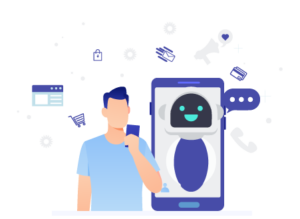How to Create Customer Relationships that Last Forever?
There are good chances you may have come across a few enterprises that have displayed tremendous growth over a certain period, while others have a smashing start only to descend into a steep dip. Now the question arises: what’s the difference between the two? The difference lies in their approach to building customer relationships and scaling them to the next level.
A good customer relationship requires constant work and attention like any other one. It takes your time to build one and further nurture it. According to research, 79% of customers said that before making any purchase or closing a deal, they want brands to show that they care and understand customers’ requirements. Businesses that understand the criticality of building strong customer relationships during the initial phase develop an emotional connection with them, which further helps them to retain their customers for a longer duration. Building a reliable customer relationship includes all interactions across the customer journey and other factors influencing this relationship. For a successful, long, and loyal customer relationship, some crucial factors should be part of customer relationship strategies.
Be There for Your Customers During the Entire Customer Journey:

According to 96% of customers, their loyalty toward a brand is highly influenced by customer service. The number itself reflects the importance of after-sales services to ensure repeat business. Usually, a failed attempt to deliver end-to-end customer support can have serious consequences, including a higher churn rate, increased number of after-sales calls from customers, lower sales, and, eventually, lower profits. A consistent and omnichannel customer experience improves customer satisfaction, retention, and sales while reducing end-to-end service expenses.
Reduce Customers’ Efforts During Their Journey:

Customers will always remain loyal to a brand if they get a hassle-free experience every time they deal with it. To provide such a customer journey with minimum effort on the customer’s part, it is essential to chalk out the customer journey and pinpoint areas where processes can be smoothened to make them more convenient for customers. The end goal should always be to provide customers with what they want wherever they are and to deliver a streamlined and rich experience.
Personalize Customer Relationships:

Establishing a lasting and reliable relationship with customers requires involvement on a personal level. According to a report by McKinsey, 71% of customers expect brands to provide personalized experiences, and 76% admitted that they become frustrated if the same isn’t delivered. Brands that understand and provide customized experiences have reported revenue greater than targets. Customers look forward to interactions where there are human-to-human conversations. A personalized customer journey positively impacts brand loyalty, conversion rates, and revenue generation.
Appreciate Customers in the form of Rewards:

One way to maintain good customer relationships is by appreciating customers. Around 69% of customers believe that their purchasing decision majorly depends on whether the brand is offering any customer rewards or not. These rewards can be in the form of incentives, discounts, premium services, or early access to a newly launched product or service.
Prompt Response:

For 90% of customers, quick resolution of their issues or questions is essential as this shows that the brand values them as customers and respects their time. Delayed or untimely responses may frustrate customers, leading to a higher churn rate. Deploying AI-powered intelligent assistants can help brands stay connected with their customers 24X7 while providing resolutions to their concerns and giving brands complete control over the customer journey.
Pay attention to Feedback:

Feedback and opinions of customers are vital if brands want to serve their customers in a better way. This feedback can quickly tell brands about areas requiring improvements and what customers expect from them. Customers are the most reliable source of information about the performance of the service or the product. Feedback can be collected through different surveys that ask customers if they would recommend the brand to others or by simply asking them to mark their satisfaction. Collecting feedback also showcases that a brand cares for what its customers think.
Adopt a Customer-Centric Strategy:

One of the most successful ways of building brand loyalty is to create and work on a customer-centric strategy along with a business culture that delivers a seamless customer experience at its core. This ensures that the customer is always at the focus and he is the center of the brand’s ideas, operations, and vision. To create and deploy customer-centric strategies, it is imperative to understand customers, their requirements, expectations, and preferred communication channels. Brands must understand the most profound customer psychology to create a successful business strategy.
Be at the Forefront in Dealing with Customer Issues:

Being proactive toward addressing customer issues can quickly improve customer retention. How? Adopting a proactive approach provides more value to your customer base, eventually impacting brand loyalty. This approach can be considered the next level of customer service, where customer needs and issues are predicted based on their history, and preemptive solutions are extended way before the requirement or problem arises. It can help brands stay abreast of their competitors as the brand offers something out of the box.
Consistent Omnichannel Support:

With the advancement in technology, there has been a massive explosion in the number of customer interaction points across new devices, applications, and channels, making it almost impossible to deliver a consistent experience. The only solution is to cover the customer journey rather than single touchpoints. Deploying an omnichannel strategy across the whole chain can help brands keep track of customer journeys without information loss in case the customer switches from one channel to the other. This helps streamline communication across all channels and makes brands accessible to customers.
Go Beyond the Expectations:

In the wake of the fierce competition, it becomes necessary for brands to deliver a notch higher than what is expected from them. With customer expectations higher than ever, extending real-time support is one of the sure-shot ways to stand out from the rest of the crowd. This approach is a win-win situation for brands as it not only helps them exceed customer expectations but also creates the desired impression.
To sum up, the bottom line among all the points mentioned above is to keep the conversation intact between the customer and brand. It is the interaction that helps build a strong customer relationship. Achieving this without overworking the customer support staff requires the right AI-powered tools. And when you have the right strategies and tools, a strong foundation for customer relationships can be built, which will go on long and long.




